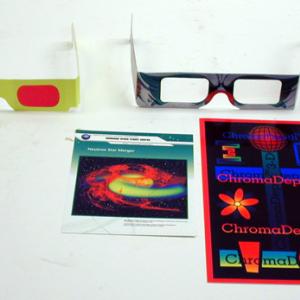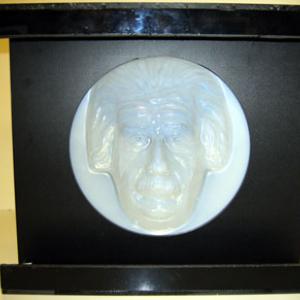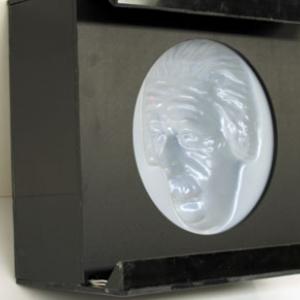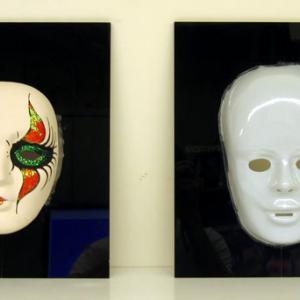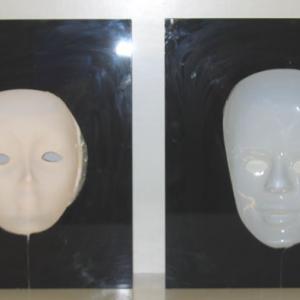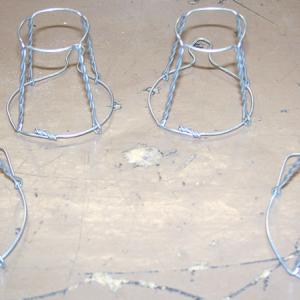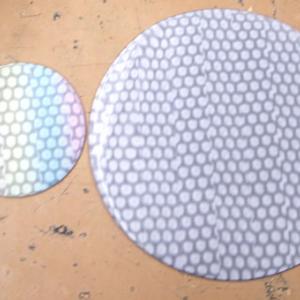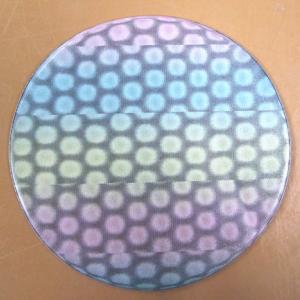College of Liberal Arts & Sciences
6J11.52 - Optical Illusions and 3-D Viewing
More Optical Illusions can be found in the 7A55.40 box.
Most of these illusions have to do with sizes or lengths of lines and their orientation.
The magic arcs are the same size however when placed one above the other the lower will always appear to be longer.
3-D viewing can be produced in several ways. The most common is to use a red filter in front of one eye and a blue filter in front of the other and look at a colored picture that has the red and blue colors slightly offset.
The Chroma Depth set produces 3-D viewing using a holographic grating effect. This can be viewed online at: http://chromatek.com/
The "Einstein is Watching You" demo is an optical illusion dealing with shadows and perception. The plastic mask is facing inward and away from you, but by casting the shadows on the face in the right manner, your brain will interpret the image as facing outward toward you. Sometimes closing one eye will enhance the effect. Another interesting effect happens when you walk around the image while looking at it. The image will appear to turn and follow you as you move. There are two lights in the demo. When the upper light is on it should allow you to see the mask facing inward as it is, and when the lower light is on it should give you the illusion of facing outward and turning to follow you.
The party and Halloween masks will give the same illusion as the "Einstein" demo above.
The dogs are an interesting version of "Einstein" demonstrating that two dimensional objects can show a 3-D effect when viewed correctly.
The wine bottle cork keeper if viewed correctly will appear to invert much the same way as the dogs and the Einstein mask as discussed above. That is, if the keeper is held with the basket facing away from you, it will instead appear that it is pointed toward you when viewed.
- Mustafa Sahin Bülbül, "Frame in the Frame: Mystery Motion on the Hill", TPT, Vol. 56, #9, Dec. 2018, p. 624.
- Svetoslav Zabunov, "Stereo 3-D Vision in Teaching Physics", TPT, Vol. 50, #3, Mar. 2012, p. 163.
- H. Schmitzer, D. Tierney, and T. Toepker, "Real 3-D: How Does It Work?", TPT, Vol. 47, #7,Oct. 2009, p. 456.
- Martin Gardner, "The Floating Vase", TPT, Vol. 40, #3, Mar. 2002, p. 187.
- Martin Gardner, "A Spooky Rotation", TPT, Vol. 40, #2, Feb. 2002, p. 123.
- Martin Gardner, "The Rotating Face", TPT, Vol. 38, #7, Oct. 2000, p. 425.
- Martin Gardner, "The Revolving Circle", TPT, Vol. 36, #9, Dec. 1998, p. 543.
- Martin Gardner, "The Tabletops Illusion", TPT, Vol. 36, #4, Apr. 1998, p. 252.
- Ferenc Riesz, "Computer Generation on 3-D Diagrams", TPT, Vol. 34, #2, Feb. 1996, p. 116.
- Curt Gabrielson, "One Brain, Two Eyes, Three-D", TPT, Vol. 34, #1, Jan. 1996, p. 10.
- Joseph Sicking, Terrence Toepker, and Greg Wojtkiewicz, "More Than Meets The Eye", TPT, Vol. 33, #7, Oct. 1995, p. 446.
- Ron Edge, "3D with Jumping Colors", TPT, Vol. 32, #9, Dec. 1994, p. 538, also referenced in Recourse Letter TLC-1 Teaching Light and Color, Demonstration Experiments Resource Articles.
- Ken Altshuler, "Art and Physics", TPT, Vol. 32, #5, May 1994, p. 271.
- John W. Jewett Jr., "LED's and the 'Fluttering Heart' Phenomenon", TPT, Vol. 31, #3, Mar. 1993, p. 180.
- Harry Rheam, "Absorption by Blue and Red Filters", TPT, Vol. 29, #6, Sept. 1991, p. 382.
- Martin Gardner, "A Square That Ain't There", TPT, Vol. 28, #8, Nov. 1990, p. 562.
- Michael J. Ruiz and Terry L. Robinson, "Illusions with Plane Mirrors", TPT, Vol. 25, #4, Apr. 1987, p. 206.
- "International Physics Education", TPT, Vol. 6, #4, Apr. 1968, p. 182.
- Laurent Hodges, "Polarized Sunglasses and Stereopsis", AJP, Vol. 52, #9, Sep. 1984, p. 855.
- Frank Oppenheimer, "The Study of Perception as a Part of Teaching Physics", AJP, Vol. 42, #7, July 1974, p. 531.
- Byoungho Lee, "Three-Dimensional Displays, Past and Present", Physics Today, Vol. 66, #4, Apr. 2013, p. 36.
- Irvin Rock, "The Perception of Disoriented Figures", Scientific American, Vol. 230, #1, Jan. 1974, p. 78.
- Bela Julesz, "Texture and Visual Perception", Scientific American, Vol. 212, #2, Feb. 1965, p. 38.
- Richard L. Gregory, "Visual Illusions", Scientific American, Vol. 219, #5, Nov. 1968, p. 48.
- Fabio Metelli, "The Perception of Transparency", Scientific American, Vol. 230, #4, Apr. 1974, p. 90.
- C. L. Strong, "The Amateur Scientist: Generating Visual Illusions with Two Kinds of Apparatus", Scientific American, Vol. 224, #3, Mar. 1971, p. 110.
- Fred Attneave, "Multistability in Perception", Scientific American, Vol. 225, #6, Dec. 1971, p. 62.
- Sara Kiley Watson, "This Triangle Doesn't Exist", Popular Science, Vol. 231, Summer 2019, p. 119.
- Marissa Shieh, "Something in Our Brain is Making These Spirals Look Like They are Moving", Popular Science, Vol. 289, #5, Sept/Oct. 2017, p. 84.
- D. Rae Carpenter Jr. and Richard B. Minnix, "O-805. Real Illusions and Spoofs", DICK and RAE Physics Demo Notebook.
- D. Rae Carpenter Jr. and Richard B. Minnix, "O-675. 3-D Color Slides", DICK and RAE Physics Demo Notebook.
- Tik Liem, "What Gives Us the Illusion?", Investigation to Science Inquiry, p. 438.
- "Poggendorff Illusion", Wikipedia, https://en.wikipedia.org/wiki/Poggendorff_illusion.
- "Delboeuf Illusion", Wikipedia, https://en.wikipedia.org/wiki/Delboeuf_illusion.
- "Zöllner Illusion", Wikipedia, https://en.wikipedia.org/wiki/Z%C3%B6llner_illusion.
- "Ponzo Illusion", Wikipedia, https://en.wikipedia.org/wiki/Ponzo_illusion.
- "Muller-Lyer Illusion", Wikipedia, https://en.wikipedia.org/wiki/M%C3%BCller-Lyer_illusion.
- "Ebbinghaus Illusion or Titchener Circles", Wikipedia, https://en.wikipedia.org/wiki/Ebbinghaus_illusion.
- "Talk: Muller-Lyer Illusion - Judd Illusion", Wikipedia, https://en.wikipedia.org/wiki/Talk%3AM%C3%BCller-Lyer_illusion.
- "Lipps Illusion",Optical Illusions and Eyetricks.
- The Upside Down T, "Illusions and Visual Special Effects - Explanations and Tutorials", Optical Illusions website, https://www.opticalillusion.net/.
- George M. Hopkins, "Optical Illusions", Experimental Science, p. 223.
- A. D. Bulman, "Some Optical Illusions", Model-Making for Physics, p. 33.
- Jodi and Roy McCullough, "Diffraction and Stereo Vision with Jumping Colors", The Role of Toys in Teaching Physics, p. 4.152.
- Tom Senior, "Cork Cage Illusion".
- Charles Vivian, "Make a 3-D Viewer", Science Experiments & Amusements For Children, p. 75.
- Pat Murphy, Ellen Macaulay, and the staff of the Exploratorium, "Optical Illusions", Exploratopia, p. 273.
- Don Rathjen and Paul Doherty, "Reverse Masks", Square Wheels, 2002, p. 81.
- Don Rathjen and Paul Doherty, "3-D Shadows", Square Wheels, 2002, p. 1.
- Don Rathjen and Paul Doherty, "Vanna", The Cheshire Cat, p. 104.
- Don Rathjen and Paul Doherty, "Mirrorly a Window", The Cheshire Cat, p. 71.
- Don Rathjen and Paul Doherty, "Jacques Cousteau in Seashells", The Cheshire Cat, p. 66.
- Don Rathjen and Paul Doherty, "Far Out Corners", The Cheshire Cat, p. 57.
- Don Rathjen and Paul Doherty, "Fading Dot", The Cheshire Cat, p. 54.
- Don Rathjen and Paul Doherty, "Disappearing Act", The Cheshire Cat, p. 47.
- Don Rathjen and Paul Doherty, "Color Contrast", The Cheshire Cat, p. 39.
- Don Rathjen and Paul Doherty, "Cheshire Cat", The Cheshire Cat, p. 35.
- Martin Gardner, "71. Ghostly Circles", Smart Science Tricks, p. 106.
- Martin Gardner, "The Vanishing Smudge", Smart Science Tricks, p. 103.
- Martin Gardner, "66. The Flexible Ovals", Smart Science Tricks, p. 100.
- Martin Gardner, "65. The Amazing Floating Vase", Smart Science Tricks, p. 99.
- Martin Gardner, "63. The Tabletops Illusion", Smart Science Tricks, p. 96.
- Martin Gardner, "60. The Rotating Face", Smart Science Tricks, p. 92.
- Martin Gardner, "55. Mysterious Circles", Smart Science Tricks, p. 86.
- Martin Gardner, "53. The Revolving Circle", Smart Science Tricks, p. 84.
- Martin Gardner, "50. An Apparition", Smart Science Tricks, p. 80.
- Martin Gardner, "The Enchanted Die", Science Tricks, p. 72.
- Martin Gardner, "A Square That Ain't There", Science Tricks, p. 70.
- Martin Gardner, "Take Another Look!", Entertaining Science Experiments with Everyday Objects, p. 44.
- Martin Gardner, "Pencil Illusion", Entertaining Science Experiments with Everyday Objects, p. 40.
- Martin Gardner, "Spooky Spiral", Entertaining Science Experiments with Everyday Objects, p. 37.
- Martin Gardner, "Penny Illusion", Entertaining Science Experiments with Everyday Objects, p. 34.
- Martin Gardner, "Moon Illusion", Entertaining Science Experiments with Everyday Objects, p. 33.
- Martin Gardner, "The Penetrating Match", Entertaining Science Experiments with Everyday Objects, p. 32.
- Martin Gardner, "Missing Slice", Entertaining Science Experiments with Everyday Objects, p. 31.
- Martin Gardner, "Circles on the Card", Entertaining Science Experiments with Everyday Objects, p. 30.
- Vicki Cobb and Kathy Darling, "Big Money", Bet You Can't!, p. 100.
- Vicki Cobb and Kathy Darling, "New Moon?", Bet You Can!, p. 21.
- Janice VanCleave, "Create an Optical Illusion", Super Science Challenges, p. 41.
- Janice VanCleave, "80. Around and Around", 200 Gooey, Slippery, Slim, Weird, & Fun Experiments, p. 43.
- "The Two-Circles Illusion", The Boy Magician, ISBN 978-1-58816-754-5, p. 145.
- "A Spiral-Cord Illusion", The Boy Magician, ISBN 978-1-58816-754-5, p. 145.
- "A Lively Optical Illusion", The Boy Magician, ISBN 978-1-58816-754-5, p. 144.
- "The Wrong-Size Cardboard Segments", The Boy Magician, ISBN 978-1-58816-754-5, p. 143.
- "A Simple Geometrical Trick", The Boy Mechanic, ISBN 978-1-58816-509-1, p. 218.
- Jearl Walker, "7.13. Op Art", The Flying Circus of Physics Ed. 2, p. 310.
- Julien Clinton Sprott, "6.12, Optical Illusions", Physics Demonstrations, ISBN 0-299-21580-6, p. 260.
- Simon Quellen Field, "Make Your Own 3D Pictures in Minutes", Gonzo Gizmos, p. 177 - 183.
- H. J. Press, "Crazy Letters", Giant Book of Science Experiments, p. 247.
- H. J. Press, "Magic Spiral", Giant Book of Science Experiments, p. 245.
- H. J. Press, "Annoying Circles", Giant Book of Science Experiments, p. 244.
- T. D. Rossing and C. J. Chiaverina, "# 1, Camouflage and Common Fate", Light Science, Physics and Visual Arts, p. 329.
- T. D. Rossing and C. J. Chiaverina, "Visual Perception and Illusions", Light Science, Physics and Visual Arts, p. 303.
- "Pointillist Physicist", New Trier Connections Project.
- "Einstein Alive!", Arbor Scientific, P2-6000.
- "Abraham Lincoln is Watching You", p. 5 - 8.
- Al Seckel, "138. Mach Illusion", The Great Book of Optical Illusions, 2002, p. 152.
- Al Seckel, "31. Poggendorf Illusion with Pillars", The Great Book of Optical Illusions, 2002, p. 39.
- Al Seckel, "1. Shepard's Tabletop", The Great Book of Optical Illusions, 2002, p. 10.
- Curt Suplee, "Perception - or Confusion?", Everyday Science Explained, National Geographic, p. 248 - 249.
- Martin Keen, "Do Your Eyes Ever Betray You?", Let's Experiment, 1968, p. 156.
- Don Herbert and Hy Ruchlis, "Your Senses", Mr. Wizard's 400 Experiments in Science, p. 9 - 12.
- Brenda Walpole, 175 Science Experiments to Amuse and Amaze Your Friends, p. 148 - 151.
- UNESCO, "B. Your Senses", 700 Science Experiments for Everyone, p. 207 - 209.
- Ron Hipschman and Jad King, "Recipe No. 111: Mirrorly A Window", Exploratorium Cookbook II, p. 111-1 - 111-4.
- Bobby Mercer, "Mesmerizing CD Top", Junk Drawer Physics, p. 1.
- Sara Stein, "Optical Illusions", The Science Book, p. 205.
- Tom McNamara, "Is This the World's First Illusion", Popular Science, Spring 2020, p. 116.
- Nicole Wetsman, "Signal In The Noise", Popular Science, Winter 2019, p. 109.
- Tik L. Liem, "The Swaying Cardboard", Invitations to Science Inquiry - Supplement to 1st and 2nd Ed. p. 151.
Disclaimer: These demonstrations are provided only for illustrative use by persons affiliated with The University of Iowa and only under the direction of a trained instructor or physicist. The University of Iowa is not responsible for demonstrations performed by those using their own equipment or who choose to use this reference material for their own purpose. The demonstrations included here are within the public domain and can be found in materials contained in libraries, bookstores, and through electronic sources. Performing all or any portion of any of these demonstrations, with or without revisions not depicted here entails inherent risks. These risks include, without limitation, bodily injury (and possibly death), including risks to health that may be temporary or permanent and that may exacerbate a pre-existing medical condition; and property loss or damage. Anyone performing any part of these demonstrations, even with revisions, knowingly and voluntarily assumes all risks associated with them.

